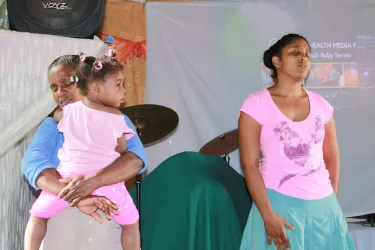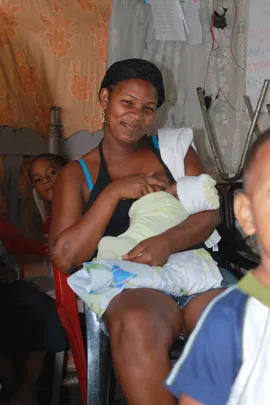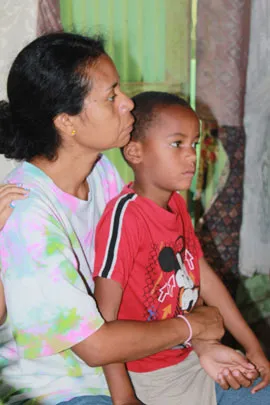A Circle of Life
A Letter from Mark Hare and Jenny Bent, serving in the Dominican Republic and Haiti
Hello Friends,
As many of you remember, Mark, Keila, Annika and I are serving with the Dominican Evangelical Church (IED) here in Barahona in the southwestern region of the Dominican Republic. Our focus is to promote and support the IED’s program of Community Health Evangelism (CHE). That involves training members of IED churches initiating CHE in their communities, but our work also involves accompanying people as they initiate their programs. I would like to share a glimpse of the achievements of two young women working with CHE in the barrio of Casandra in the hills of southern Barahona.
Bellanira and Andreina are two young women who live in Casandra and are members of the local IED congregation, the 3rd IED church of Barahona. Both are about 25 years old and are university students as well as trainers and promoters of CHE for their church and their community. Bellanira is studying biology with a focus in education, and Andreina is studying nursing. In addition to leading the CHE initiative, they coordinate a water project that provides that precious liquid to over a hundred households in the Casandra neighborhood. Bellanira also helps with Sunday School at the IED congregation and participates in Saturday evening gatherings and youth worship at her church. I respect and admire both young women for their dedication to the well-being of their community, their church and their families. They are very busy, and they are also very intelligent and lovely people.

Each Monday, I meet with Bella, Andreina and Pastora Belkis Santana. Together with her husband, the pastor is a co-founder of a small but vibrant local Pentecostal church. Together with Bella and Andreina, Pastora Belkis forms part of the committee that manages the water project. She recently became interested in working with Bella and Andreina on CHE.
Our Monday meetings generally start with prayer, a song and a devotional, and then we begin addressing the day’s agenda. My work is to help facilitate the organization of the activities these three women decide to carry out in the community. I always arrive at the meeting with more questions than ideas. It is during the meeting that ideas emerge. There are days when I have a clear vision of the direction I would like the meeting to take, but it rarely goes the way I would like. What often happens is that the vision I bring to the meeting takes a backseat because Bella, Andreina and the pastor also bring their ideas and their unique energy. My obligation is to recognize their creativity and work to help it grow in the instant that it presents itself. This is a reciprocal process that the four of us are practicing and developing together.

I experience the same type of dynamics with my daughters as I homeschool them. They teach me as I teach them, just as happens with Bella, Andreina and Pastora Belkis. That is the beauty of CHE. It puts into practice a process in which all of us are simultaneously students and teachers. Our mutual learning is constructed starting from our respective daily experience. It is a participatory process, and it leads to self-discovery — individuals find themselves teaching themselves and each other new ideas and techniques that make sense because the process happens within their own daily reality, their own context. At its best, CHE empowers, creating resilience and celebrating the dignity of the women, children, older adults and men who participate.
This past Monday, Mark and I witnessed this process in action during an activity that Bella, Andreina and Pastora Belkis organized, “Elaboration of Baby Carriers with Mothers of Casandra.” Two days before the activity, they invited ten women and asked them to bring a bedsheet to create their baby carrier. The workshop was organized and directed mainly by Bella and Andreina. Pastora Belkis assisted by providing a biblical reflection based on Psalms 127:3 and Luke 11:27-28.
Bellanira demonstrated how to create the baby carrier, while Andreina facilitated conversation among the women about the carrier’s advantages. She observed that a mother can carry her baby while keeping her hands free, making it possible for her to carry out the tasks in the household as well as walk with the baby to local shops, keeping the baby near her at all times. With the carrier, a mother can protect her baby from sun and wind, keeping the child warm and providing constant security. The baby is also near the mother’s breast, making nursing easy. Andreina pointed out that nursing is an important step in strengthening the bonds of affection between mother and child.

One mother shared her daily experiences of caring for babies. She said that Dominican mothers generally leave their babies on the bed or on the floor on some kind of cover so that they can attend to the household chores, even if the baby cries. The belief is that the baby will be “añoñada,” or “spoiled,” if the mother carries the baby a lot. Andreina responded by saying that she doesn’t think that is a good practice because it teaches the baby from a tender age that there are things more important than her.
One of the nicest things was that the women came to the workshop with their babies, from the youngest who was a tender 11 days old up to a 3-year-old toddler. Each mother had the opportunity to use her sheet to put together the baby carrier and to try out its efficacy with their own babies. There was a lot of laughter and a deep sense of trust, contentment and sisterhood.
At the end, we had a little snack for the women and also a surprise for Bellanira. We had brought a cake because it was Bellanira’s birthday. Amid smiles and cries of babies, we celebrated the years that Bella has completed and the experiences each new day brings.
What would we do differently in another workshop? I believe we should invite more men, particularly fathers. Next meeting, I will ask my companions from Barrio Casandra what they think.
The resources that we used in this activity were minimal: some old sheets, a Bible, a humble community church, the participation of mothers and their babies, the interest and excitement of Andreina, Bella and Pastora Belkis, and the bits of knowledge and experiences that each of us brought with us. That is what CHE is about — using local resources to instruct and to create new options, always remembering to integrate the physical, the emotional, the intellectual and the spiritual.
From your homes, your communities and your churches, you all have supported the process of CHE here in Barahona and in other parts of the Dominican Republic. I hope this story encourages you to continue in your accompaniment and support of this path. Our Lord God calls us to be witnesses and co-participants in God’s ongoing creation and re-creation. May you continue to be part of that process wherever you are.
Jenny, Mark, Keila and Annika
